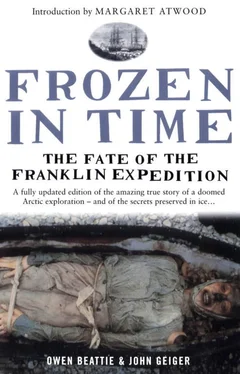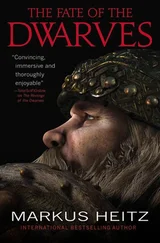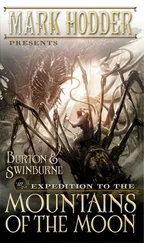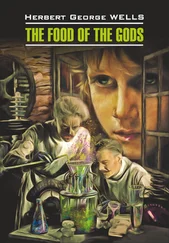Before the excavation of Hartnell’s grave was complete, Beattie visited a site that would add important insights into his research. Located nearly ⅔ mile (1 km) north of the gravesite, at the narrowest point of the island near the spit, is a large oval mound with a central depression filled with the fragments of hundreds of rusted and disintegrating food tins from Franklin’s expedition. When this location was discovered in August 1850, searchers found a neat arrangement of 700 or more tins piled “like shot” into low pyramids about 1½ feet (.5 metre) high. The tins were empty of food and had been filled with gravel. The reason for the “cairn,” as it was described, is not clear. But not wanting to miss any possible clue left behind by Franklin’s people, the searchers of 1850 thoroughly investigated each of the tins, dumping out the gravel. Literally leaving no stone unturned, they also dug into the ground underneath the tins with the hope of finding a buried document. It is this excavation that produced the oval mound and depression that mark the site today.
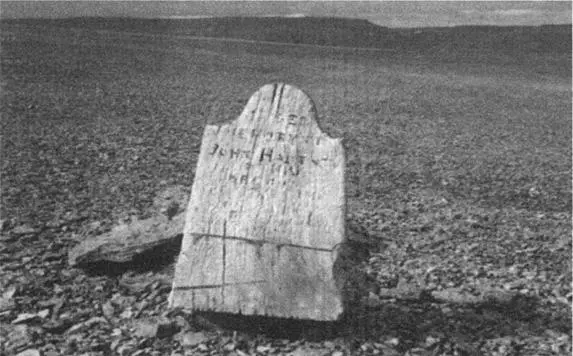
The grave of 25-year-old John Hartnell.
There has been much debate about the significance of these tins. It was thought that the “cairn” was evidence of problems with the preserved food. Certainly, by the 1850s, Stephan Goldner, who had supplied the Franklin expedition, was encountering problems with the quality of the tinned foods he delivered to later expeditions. And more than one of the searchers in the 1850s observed that a number of the tins at Beechey Island had bulging ends, evidence that some of the food had putrefied. Still, one searcher, Peter Sutherland, wrote that the tins “were carefully examined without anything being discovered that could lead to the remotest idea that the preserved meat which they contained had been in an unsound state.” And one twentieth-century historian has argued that the number of tins present at the site was not in excess of what was expected to have been used by the expedition during their stay on Beechey Island. In other words, there was no evidence for large quantities of bad food being dumped on the island.
Beattie had seen photographs of food tins from various British Arctic expeditions and had handled a few, but as he picked through the tins from Franklin’s expedition, he saw that they were different. The lead soldering was thick and sloppily done, and had dripped like melted candle wax down the inside surface of the tins. Beattie wondered if this could be the source of the lead in the Booth Point skeleton and in the human remains collected elsewhere on King William Island. This idea became more credible to him as each piece of tin he picked up demonstrated the same degree of internal contamination from the solder. Samples were collected for further examination and plans made to return for a comprehensive study of the site.
Meanwhile, Kowal was finding the excavation of Hartnell’s grave much more difficult than had been experienced with Torrington. The permafrost was harder and more consolidated than was encountered in the other grave, and he constantly commented on this difference. The increased difficulty in the pick and shovel work hinted that the grave had been disturbed, then refrozen. As digging continued, more fragments of wood and blue material were pulled from the grave fill itself, reinforcing Beattie’s view that the previous disturbance had been considerable and may have involved the exposure of the coffin, and probably Hartnell’s body as well.
Shortly, Kowal announced that he had found the foot-end of the coffin. To everyone’s surprise it was not deeply buried, only 33 inches (85 cm) into the ground. They had expected a burial at least as deep as Torrington’s.
The white tape decoration on it was in poor condition, and, as Kowal continued to clear the permafrost from the top of the lid, he uncovered other areas of damage. “Someone sure did a number on this grave,” he said, as he finished exposing the lid. The right-hand side at the forearm level had been smashed through, leaving a gaping hole. It was possible to identify each blow of the pickaxe that had done the damage. A large rectangular piece of the blue fabric adjacent to the hole was missing. The lid, originally nailed to the coffin, was slightly ajar, the nails having either been removed or broken. There was no doubt that the coffin had been exposed and opened before. The condition of the white fabric tape decoration was in stark contrast to the symmetrical dignity of Torrington’s coffin, and Beattie was shocked by the damage, which at first appeared to have been caused by a wanton act of vandalism. But as work continued it became obvious that, though there had been considerable damage done during the previous excavation, it was not the work of vandals or pot hunters. The lid had been replaced and the nails appeared to have been carefully removed. Vandals would have simply pried the lid off the coffin, causing major structural damage.
Beattie jumped into the grave and bent over the hole in the lid. Pulling some of the gravel out of the hole, he said, “Look at this—Hartnell’s shirt!” A small piece of fabric, nearly identical in design to John Torrington’s shirt, had come free from the ice. The fabric, obviously part of the right shirt sleeve, was torn, and the thought entered Beattie’s mind that, if the clothing had been damaged in the area of the hole in the lid, perhaps there was damage to Hartnell’s body as well.
Unlike Torrington’s, there was no plaque on the lid of Hartnell’s coffin, and Beattie believed the plaque was removed by the people who had exposed the coffin. A close inspection of the wood in the area where a plaque would have been fixed did not reveal any nail holes, though it is possible they could have closed since the time of the plaque’s removal. A less satisfactory interpretation was that, being an able seaman, Hartnell did not warrant a plaque. But considering that his messmates (including his younger brother Thomas) would normally have been responsible for the preparation of a plaque, it seemed likely there had been one. Not only had Hartnell been buried at only a little more than half the depth of John Torrington, the coffin also did not seem to be aligned with the headboard. As the researchers intended to expose no more than the coffin lid, an assessment of the damage to the rest of the coffin would have to wait until their planned return.
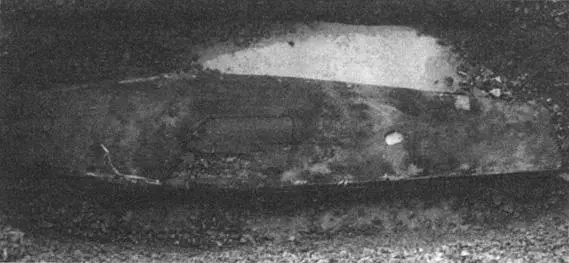
John Hartnell’s coffin, damaged in 1852 when his body was exhumed by Commander Inglefield and Dr. Sutherland.
When Kowal lifted the coffin lid on 23 August, everyone was crouched round the graveside. Inside Hartnell’s coffin there was again a solid block of ice. “There is no doubt that he will be as well preserved as Torrington,” Beattie said. However, unspoken was a fear that Hartnell’s body, as well as the coffin, had been damaged. There was only one way to confirm these fears.
Exhumed, John Torrington was a frail, innocent-looking young man. He did not fit the image of a sea-toughened sailor and adventurer, but simply of a young man who died too soon. Because of this, not one of the scientists was prepared for what awaited them a few inches below the ice in Hartnell’s coffin.
Kowal poured water over Hartnell’s face area and soon spotted the outline of a nose through the receding ice. While John Torrington’s face had been slightly discoloured by contact with the coffin covering and by exposure to a pocket of air, Hartnell’s nose appeared natural in colour. Gradually, Kowal could see a ghostly image taking shape through the ice—a frightening, shimmering face of death.
Читать дальше
